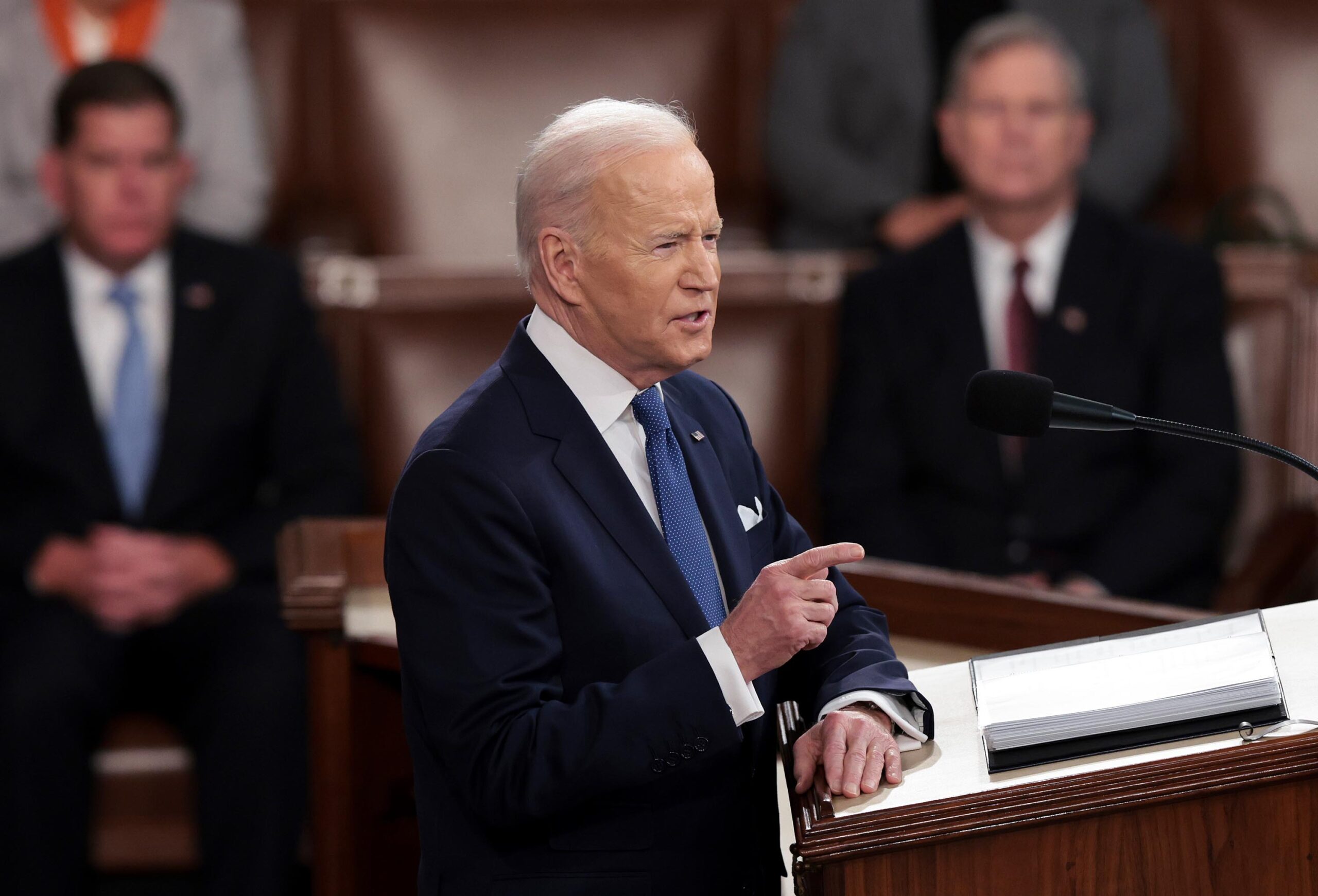
President Joe Biden Delivers His State Of The Union Address To A Joint Session Of Congress At The Capitol, Tuesday, March 1, 2022, In Washington
Addressing a concerned nation and anxious world, President Joe Biden vowed in his first State of the Union address Tuesday night to check Russian aggression in Ukraine, tame soaring U.S. inflation at home and deal with the fading but still dangerous coronavirus.
He asked the lawmakers crowding the House chamber to stand and salute the Ukrainians as he began his speech. They stood and cheered.
Biden, in remarks before Congress, highlighted the bravery of Ukrainian defenders and the resolve of a newly reinvigorated Western alliance that has worked to rearm the Ukrainian military and cripple Russia’s economy through sanctions.
Biden said the U.S. would ban Russia from its airspace.
He warned of costs to the American economy, as well, but warned ominously that without consequences, Russian President Vladimir Putin’s aggression wouldn’t be contained to Ukraine.
“Throughout our history we’ve learned this lesson – when dictators do not pay a price for their aggression, they cause more chaos,” Biden said. “They keep moving. And, the costs and threats to America and the world keep rising.”
As Biden spoke, Russian forces were escalating their attacks in Ukraine, having bombarded the central square of country’s second-biggest city and Kyiv’s main TV tower, killing at least five people. The Babi Yar Holocaust memorial was also damaged.
Many lawmakers wore pins on their lapels honoring Ukraine.
Even before the Russian invasion sent energy costs skyrocketing, prices for American families had been rising, and the COVID-19 pandemic continues to hurt families and the country’s economy.
Biden was outlining plans to address inflation by reinvesting in American manufacturing capacity, speeding supply chains and reducing the burden of childcare and eldercare on workers.
“We have a choice,” Biden said. “One way to fight inflation is to drive down wages and make Americans poorer. I have a better plan to fight inflation. Lower your costs, not your wages.”
Biden entered the House chamber without a mask, in a reflection of the declining coronavirus case counts and new federal guidance meant to nudge the public back to pre-pandemic activities. But the Capitol was newly fenced due to security concerns after last year’s insurrection.
Set against disquiet at home and danger abroad, the White House had conceived Tuesday night’s speech as an opportunity to highlight the improving coronavirus outlook, rebrand Biden’s domestic policy priorities and show a path to lower costs for families grappling with soaring inflation. But it has taken on new significance with last week’s Russian invasion of Ukraine and nuclear saber-rattling by Putin.
As is customary, Energy Secretary Gina Raimondo was kept in a secure location during the address ready to take over the government in the event of a catastrophe, in holdover from the Cold War that took on new significance in light of Putin’s threats.
In an interview with CNN and Reuters, Zelenskyy said he urged Biden to deliver a strong and “useful” message about Russia’s invasion. Ahead of the speech, the White House announced that Ukrainian Ambassador to the U.S. Oksana Markarova would join first lady Jill Biden in the galleries to watch Biden’s address.
Rising energy prices as a result of Russia’s war in Ukraine risk exacerbating inflation in the U.S., which is already at the highest level in 40 years, eating into people’s earnings and threatening the economic recovery from the pandemic. And while the geopolitical crisis in Eastern Europe may have helped to cool partisan tensions in Washington, it didn’t erase the political and cultural discord that is casting doubt on Biden’s ability to deliver on his pledge to promote national unity.
Biden spoke to an American public that is frustrated with his performance. A February AP-NORC poll found that more people disapproved than approved of how Biden is handling his job, 55% to 44%. That’s down from a 60% favorable rating last July.
Ahead of the speech, White House officials acknowledged the mood of the country is “sour,” citing the lingering pandemic and inflation. Biden, used his remarks to highlight the progress from a year ago — with the majority of the U.S. population now vaccinated and millions more people at work — but also acknowledged that the job is not yet done, a recognition of American discontent.
Biden aides say they believe the national psyche is a “trailing indicator” that will improve with time. But time is running short for the president, who needs to salvage his first-term agenda to revive the political fortunes of his party before November’s midterm elections.
Before Biden spoke, House Republicans said the word “crisis” describes the state of the union under Biden and Democrats — from an energy policy that lets Russia sell oil abroad to challenges at home over jobs and immigration.
“We’re going to push the president to do the right thing,” said House Minority Leader Kevin McCarthy.
At least a half dozen lawmakers, including Reps. Jamie Raskin and Pete Aguilar, both members of the committee investigating last year’s Capitol riot, and Sen. Alex Padilla, D-Calif., had tested positive for COVID-19 and were not expected at the Capitol for the speech.
Where his speech to Congress last year saw the rollout of a massive social spending package, Biden this year largely repackaged past proposals in search of achievable measures he hopes can win bipartisan support in a bitterly divided Congress before the elections.
The president also highlighted investments in everything from internet broadband access to bridge construction from November’s $1.2 trillion bipartisan infrastructure law as an example of government reaching consensus and delivering change for the nation.
He also appealed to lawmakers to compromise on rival competitiveness bills that have passed the House and Senate, both meant to revitalize high-tech American manufacturing and supply chains in the face of growing geopolitical threats from China.
“Instead of relying on foreign supply chains – let’s make it in America,” Biden said.
The speech came as progress on many of Biden’s other legislative priorities remains stalled on Capitol Hill, after Democratic Sen. Joe Manchin scuttled the sweeping “Build Back Better” spending bill that Biden championed last fall.
As part of his pitch to voters, Biden looked to resurrect components of the legislation, but with a new emphasis on how proposals like extending the child tax credit and bringing down child care costs could bring relief to families as prices rise. He was also outlined how his climate change proposals would cut costs for lower- and middle-income families and create new jobs.
As part of that push, Biden called for lowering health care costs, pitching his plan to authorize Medicare to negotiate prescription drug prices, as well as an extension of more generous health insurance subsidies now temporarily available through the Affordable Care Act marketplaces where 14.5 million people get coverage.
He proposed new initiatives on mental health that dovetail with growing bipartisan interest in Congress amid evidence that the pandemic has damaged the national psyche, and discussed new ways to improve access to health benefits for veterans sickened by exposure to the burning of waste during their service, officials said.
Biden also appealed for action on voting rights, gun control and police reform, which have failed to win significant Republican backing.
In addition, the president to pushed the Senate to confirm federal judge Ketanji Brown Jackson to be the first Black woman on the Supreme Court. He nominated her last week.
The physician’s office for Congress recently ended the House’s face-covering requirement after the government eased its mask-wearing guidelines. Mask wearing is now optional in the House chamber, which was open to all members of Congress but not their guests. Attendees were required to take COVID-19 tests before the speech.
For some members of Congress spacing out in the chamber for coronavirus protocols, it’s their first time to the third-floor gallery since they sheltered there during the Jan. 6, 2021 insurrection, hiding from the pro-Trump mob.
Seating for Biden’s address to a joint session of Congress last April was capped at about 200, about 20% of usual capacity for a presidential speech. White House aides fretted that a repeat Tuesday would spoil the message the president aimed to deliver.
Biden Pledges US Forces “Are Not Engaged And Will Not Engage In The Conflict With Russian Forces In Ukraine”
President Biden reiterated Tuesday that the US would not deploy troops to Ukraine following Russia’s invasion, telling members of Congress gathered for his State of the Union, “Let me be clear — our forces are not engaged and will not engage in the conflict with Russian forces in Ukraine.”
Instead, the President said, American troops were deployed to Europe not to fight in Ukraine, “but to defend our NATO allies in the event that Putin decides to keep moving west.”
“For that purpose, we have mobilized American ground forces, air squadrons, ship deployments to protect NATO countries including Poland, Romania, Latvia, Lithuania, and Estonia,” he added.
Previously, Biden has said the US would hold fast to NATO’s Article 5 principle, which says that an attack on one NATO country is an attack on all member counties—in Tuesday’s remarks, he pledged, “As I’ve made crystal clear, the United States and our Allies will defend every inch of territory of NATO countries with the full force of our collective power.”
For Ukraine, the President touted “more than $1 billion in direct assistance to Ukraine,” including military, economic, and humanitarian aide from the US and allies.





